Bavaria - Munich I
| bottom |
Homepage Feedback? Enter your comments in the guest book |
Paris | |
| Previous | Back to Travelogue | Next |
11 of 15 |
|
Click on any picture to bring up the picture enlarged in a new window |
|||
 Margaret and I ventured into Munich by ourselves to see the sights. Here is
a map showing the city center. We took the train into Munich after Frieda explained
which stop to get off - the trip took about 10 minutes.
We got off the train near the Marienplatz, which is the heart of the city of
Munich. In the Middle Ages, the square used to be a market
place as well as the place where tournaments and festivities
took place.
Margaret and I ventured into Munich by ourselves to see the sights. Here is
a map showing the city center. We took the train into Munich after Frieda explained
which stop to get off - the trip took about 10 minutes.
We got off the train near the Marienplatz, which is the heart of the city of
Munich. In the Middle Ages, the square used to be a market
place as well as the place where tournaments and festivities
took place.
Munich's founding is attributed to the Guelph Duke, Henry of the Lions, who was appointed Duke of Bavaria in 1156. Modern Munich with its approximately 1.5 million inhabitants, grew from what was originally a small settlement around a Benedictine monastery. A few kilometers nearby was the route the salt traders used to transport their goods. Along this route it was necessary to cross the river Isar. The only possibility was a bridge, which was subject to tolling and lay in the territory of the Bishop of Freising. In order to reap the benefits of this toll system, Duke Henry demanded in 1158 that the old bridge near Oberföhring (today a part of the city of Munich) be destroyed and that a new bridge over the Isar be built on the site of the present Ludwigsbrücke. Munichen that was later to be Munich was born thus born. The town Apud Munichen derived its name from the then existing monastery: Bei den Mönchen (amongst the monks). At the site of this monastery today Munich’s oldest parish church. |
|
In 1255 Munich became the home of the Wittelsbach family, which had succeeded to the duchy of Bavaria in 1180.
For more than 700 years the Wittelsbachs would be closely connected with the town's destiny. In the early 14th
century the first of the Wittelsbach line of Holy Roman emperors, Louis IV, called "the Bavarian", expanded the
town to the size at which it remained up to the end of the 18th century. Under the Bavarian elector Maximilian I
(1597-1651), a powerful and effective ruler, Munich increased in wealth and size and prospered until the Thirty
Years' War (1618-1648). It was occupied by the Swedes under Gustavus Adolphus in 1632, and in 1634 a plague
epidemic killed off one-third of its population.
The third Wittelsbach who left his mark on the community was Louis I, king of Bavaria from 1825 to 1848. It was he who planned and created modern Munich, and it was his architects who established the city's characteristic appearance in the public buildings they designed. The 19th century was Munich's greatest period of growth and development. Protestants became citizens for the first time in what had been until then a purely Roman Catholic town. The city's population of 100,000 in 1854 grew to 500,000 by 1900. Munich's cultural importance in Europe was enhanced when Louis II, by his championing of the composer Richard Wagner, revived its fame as a city of music and the stage. Munich is the third largest city in Germany (after Berlin and Hamburg). Munich is by far the largest city in southern Germany. It lies about 30 miles (48 km) north of the edge of the Alps and along the Isar River, which flows through the middle of the city. The University of Munich was moved from Landshut to Munich in 1826 by Louis I. Among the city's other important educational establishments are the Technical University of Munich, founded in 1868, and academies of art, music, philosophy, military studies, and film and television. Munich has long been a center for the arts. Music, especially opera, has flourished. In addition to the Bavarian State Opera Company and the Munich Philharmonic and other orchestras, there are the Bavarian State Dramatic Company and numerous private theatres. Important libraries include the Bavarian State Library, the University Library, and the library of the Deutsches Museum (a science library). Munich has some outstanding museums and art galleries. The Alte Pinakothek houses the art treasures accumulated by the Wittelsbach family since the 16th century. Its collections of Renaissance-era German and Dutch paintings and Flemish Baroque paintings are especially strong, with many masterpieces by Albrecht Dürer, Peter Paul Rubens, and Anthony Van Dyck. In addition to the Alte Pinakothek and the Glyptothek, there are the Neue Pinakothek ("New Picture Gallery"), which houses Munich's main collection of 19th- and 20th-century art; the Bavarian National Museum, which contains German art and applied art since the Middle Ages; and the Residenz Museum, which has paintings, sculpture, furniture, and ceramics. The Deutsches Museum on an island in the Isar River is a huge and comprehensive museum of science, engineering, and technology. There are also the State Gallery of Modern Art and numerous small art galleries. |

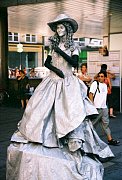 Margaret poses with Munich in the background.
At right, a street
performer who at first glance appears to be a statue.
Margaret poses with Munich in the background.
At right, a street
performer who at first glance appears to be a statue.
|
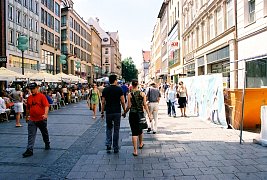 Here is the street scene as we begin to walk to our first
destination, the Frauenkirche, which is the largest Gothic church
in Germany. Note the places to sit
along the left hand side of the street.
Neuhauserstrasse and Kaufingerstrasse form one continuous strip leading
from Karlsplatz through the center of the Old Town. The streets have been
turned into a gigantic pedestrian zone.
Here is the street scene as we begin to walk to our first
destination, the Frauenkirche, which is the largest Gothic church
in Germany. Note the places to sit
along the left hand side of the street.
Neuhauserstrasse and Kaufingerstrasse form one continuous strip leading
from Karlsplatz through the center of the Old Town. The streets have been
turned into a gigantic pedestrian zone.
|
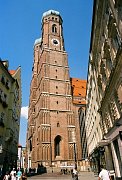 The Frauenkirche or Church of Our Lady is a Munich landmark featured on postcards
The foundation stone was laid by Duke Sigismund in 1468. The building measures 109 meters high and is 40 meters wide. Its distinctive domes, which were built in 1525 would serve as a model for many of Bavaria's towers.
The church is huge but simple. Much of the original gothic interior has been destroyed or removed partially by contra-reformists. In the crypt, you will find the tombs of the Wittelsbach family, where many dukes and bishops are buried.
The Frauenkirche or Church of Our Lady is a Munich landmark featured on postcards
The foundation stone was laid by Duke Sigismund in 1468. The building measures 109 meters high and is 40 meters wide. Its distinctive domes, which were built in 1525 would serve as a model for many of Bavaria's towers.
The church is huge but simple. Much of the original gothic interior has been destroyed or removed partially by contra-reformists. In the crypt, you will find the tombs of the Wittelsbach family, where many dukes and bishops are buried.
|
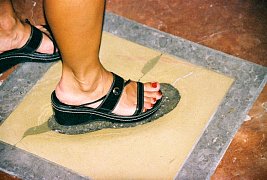
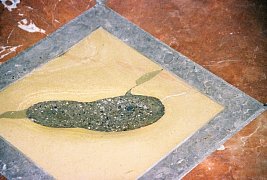
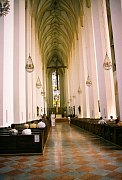
|
| inside the church is the 'footprint of the devil'. According to the legend, the architect of the Frauenkirche, Jörg von Halsbach, promised the devil you could not see a window from the inside of the church. In return, the devil would help him build the Frauenkirche. After he completed the building, the architect led the devil to the middle of the church from where you could not see a single window, although all churchgoers would sit in an area where a lot of light came through the windows. The devil stamped his foot with so much rage that his footprint was visible in the stone floor. The rightmost picture shows the view from the devil's footprint into the church. back to 2007 visit |
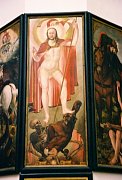 Here was an interesting hinged panel showing what appears
to me to be Jesus' power over
the Grim Reaper.
Here was an interesting hinged panel showing what appears
to me to be Jesus' power over
the Grim Reaper.
|
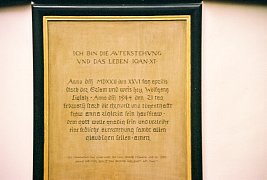 I am going to have to get an interpretation of this ....
I am going to have to get an interpretation of this ....
|
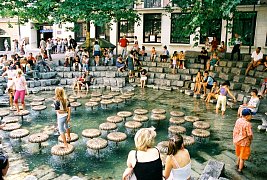 Just outside the Frauenkirche is this shady place for
people to gather. It was very welcome in the record heat. Notice
all the children it has attracted.
Just outside the Frauenkirche is this shady place for
people to gather. It was very welcome in the record heat. Notice
all the children it has attracted.
|
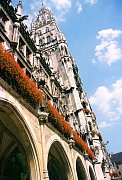
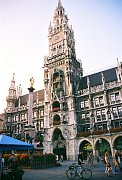
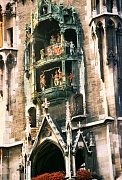 Here we are back in Marienplatz at the neo-Gothic Neues Rathaus (New Town Hall) built between
1867-1909.
I try to show here some of the towers, spurs and
gargoyles visible from the
six courtyards on the
north side of Marienplatz. On the Neues Rathaus' central tower
(Rathausturm) is a 43 bell clock (Glockenspiel),
which comes to life every day at 11 a.m. and noon
(also at 5 p.m., Mar.-Oct.) as life-size figures from
Munich's history come dancing out to its four
melodies. The Schäfflertanz, a dance which
celebrates the end of the plague in 1517, is
performed by dancers in the city streets every
seven years (the next performance is due in 2005).
On top of the dancers, figures hold a tournament, which was originally held in 1568 at
the wedding of Wilhelm II and Renata von Lothringen in 1568. The Glockenspiel exists
since 1903, but the original clocks have been replaced by a music tape.
You can also go up to the tower to have a great view of the city for two Euros - but we
didn't know about that ... there is even an elevator.
Here we are back in Marienplatz at the neo-Gothic Neues Rathaus (New Town Hall) built between
1867-1909.
I try to show here some of the towers, spurs and
gargoyles visible from the
six courtyards on the
north side of Marienplatz. On the Neues Rathaus' central tower
(Rathausturm) is a 43 bell clock (Glockenspiel),
which comes to life every day at 11 a.m. and noon
(also at 5 p.m., Mar.-Oct.) as life-size figures from
Munich's history come dancing out to its four
melodies. The Schäfflertanz, a dance which
celebrates the end of the plague in 1517, is
performed by dancers in the city streets every
seven years (the next performance is due in 2005).
On top of the dancers, figures hold a tournament, which was originally held in 1568 at
the wedding of Wilhelm II and Renata von Lothringen in 1568. The Glockenspiel exists
since 1903, but the original clocks have been replaced by a music tape.
You can also go up to the tower to have a great view of the city for two Euros - but we
didn't know about that ... there is even an elevator.
|
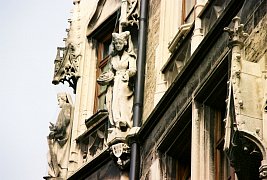
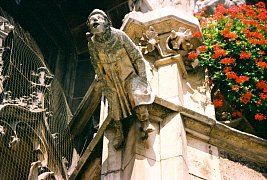
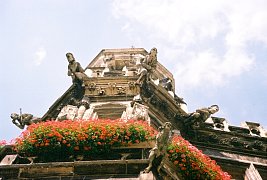
|
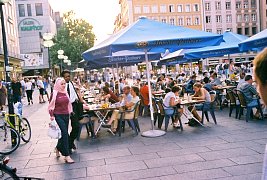
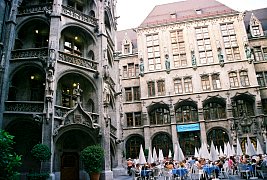
|
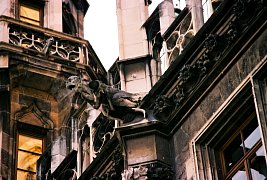
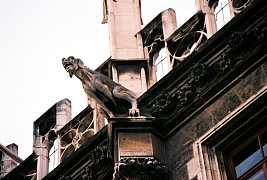
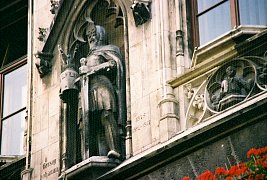
|
| top |
Homepage Feedback? Enter your comments in the guest book |
Paris | |
| Previous | Back to Travelogue | Next |
11 of 15 |
|
Click on any picture to bring up the picture enlarged in a new window |
|||